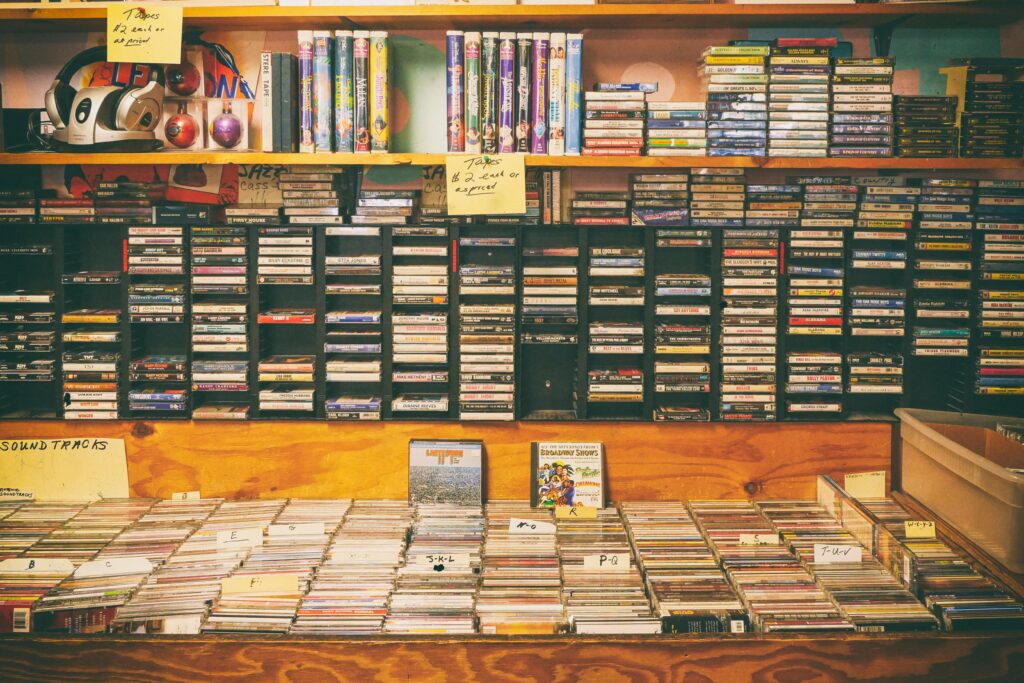
When the CD was first introduced in the 1980s, it was packaged in a plastic jewel case. This design was simple and functional but lacked the creativity and aesthetic appeal of vinyl records, which had been the dominant format for music recordings for several decades and provided a very large surface for the album cover design. Conceptual designs that tied to the back side of the cover created even larger canvases for album designers to show their artistry.
In the 1990s, the music industry began experimenting with new CD packaging designs. One popular design was the “longbox,” which was essentially a cardboard box that was the same height as a vinyl record but slightly wider. The longbox was designed to be placed on store shelves alongside vinyl records, and its size made it more noticeable than the standard jewel case, although a good idea on its own, this model did not last for too long and the practicality of the Jewel Case dominated the industry for the decades to come, with one downside; the surface for album art was much smaller and seamless designs were almost nonexistent as jewel cases came with front, back and side sections separated by the framing of the case.
In the late 1990s, the digipack emerged as a popular CD packaging design. The first digipacks were produced by the German company AGI (Advanced Graphics International) and were used to package the CD releases of the band Kraftwerk. The digipack was an instant hit with music fans and artists alike. Its paper or cardboard construction gave it a more organic and tactile feel than the plastic jewel case, and its ability to hold a booklet or other printed materials gave artists a new canvas on which to express their creativity. No more dealing with producing booklets out of the thinnest paper available, and no more page limitations, as the fold mold of digipacks could be altered based on the content they were supposed to hold.
In the early 2000s, the digipack became the packaging of choice for many indie and alternative artists. These artists valued the digipack’s DIY aesthetic and its ability to be produced in small quantities without the need for expensive equipment. This redefined the conceptuality of the album cover designs as well; as seamless designs came back into the game, creating a horizontal canvas both in the front and in the back of an album cover. Album designers began altering their approach from square-based concepts to wider concepts.
Over the years, the digipack has evolved in several ways. Some designers have experimented with different types of paper and card stock to create unique textures and finishes, while others have added die-cuts, embossing, and other special effects to make their digipacks stand out. One notable evolution of the digipack became the “digipak,” don’t let the misspelling misguide you, this is the official name of it! It is the type most commonly used nowadays; a type of digipack that includes a plastic tray to hold the CD. The digipak combines the best of both worlds by offering the tactile feel of paper or cardboard with the protection and durability of plastic.
In recent years, some artists have abandoned physical packaging altogether in favor of digital releases. However, many music fans still appreciate the tangible experience of owning a physical copy of their favorite album, and let’s be honest, merch is a form of earning for most musicians, regardless of their activities on stage or online. In this community, the digipack remains a popular choice for artists and labels looking to create a unique and memorable packaging design for their music.
While the music industry continues to evolve and adapt to new technologies, it is likely that the digipack will remain a staple of physical music packaging for many years to come.
Here at AlbumCoverZone, we offer exclusive ready-made CD cover art designs, but if you wish to have a Digipack or a Digipak product, we can provide that to you as well! You can look for extra services we provide via https://albumcoverzone.com/services and contact us to discuss your unique design ideas!

